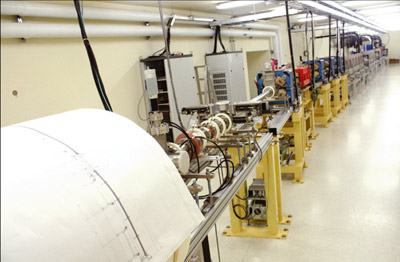
Only four months after the crates containing parts of the new electron linac system touched ground at the test site, the National Synchrotron Radiation Research Center (NSRRC) completed the commissioning of the linac system for its second synchrotron light source facility, the Taiwan Photon Source (TPS), on 6 May.
This is a major milestone in a challenging project that has had to contend with waves of worldwide recession, turbulent inflation, price fluctuations for raw materials, and unforeseen obstacles in civil construction. The contract to design and manufacture the single turn-key system, with a minimum output energy of 150 MeV, was awarded to RI Research Instruments GmbH, Germany, in November 2008. The basic design parameters stipulated 2997.924 MHz (S band) radio frequency, pulse duration of 1 ns and 200–1000 ns for short and long pulses respectively, and a maximum repetition rate of 5 Hz. The linac consists of an electron gun, a focusing and bunching section, and an accelerating section. The electron gun is capable of providing pulsed nanosecond electrons with an energy of 90 keV. Once produced, the electrons are further focused, longitudinally bunched and transferred to the 20-m long-accelerating section. This has three acceleration structures equipped with three high-power microwave amplifiers, in which the electrons are accelerated to 150 MeV.

The linac is the first TPS subsystem to require many supporting subsystems in order to proceed in its testing. During the development, various unexpected situations were encountered and steps were taken to deal with them; these included the availability of the test site ahead of the completion of the building for the TPS storage ring. The establishment of a full-scale linac test site placed an additional workload on the TPS construction teams.
The construction of the linac test site and the process to obtain operating permission from the Atomic Energy Committee occupied the last four months of 2010. In January 2011, the TPS subsystem teams moved in and began working around the clock to set up the facility. Later they joined forces with the engineering teams from RI Research Instruments GmbH to install and test the linac. The effective collaboration between the different teams was a key factor in the smooth and successful commissioning of the linac. Having the TPS linac system up and running opens a number of channels for engineers to test their systems, especially those developed in house by the NSRRC staff including the control and instrumentation group.
The TPS will be equipped with a 3 GeV electron accelerator
The design of the linac system by the four-member linac team began in the spring of 2006 and by June 2008 it was made available for an open bid to vendors worldwide. In November 2008, the project was awarded to ACCEL Instruments GmbH (acquired by Bruker Energy & Supercon Technologies Inc in 2009). This gave RI Research Instruments GmbH, a spin-off division from ACCEL, 27 months to prepare the complete system for commissioning with beam. After the first parts arrived at the linac test site in January 2011, the TPS linac team geared up to prepare for the acceptance test. The intense schedule put linac staff on a 24-hour shift to work on the project, in particular on the high-power RF conditioning of the accelerating structures. This effort reached a conclusion on 5 May, with an output energy greater than 150 MeV and measurement of the major beam parameters.

The TPS will be equipped with a 3 GeV electron accelerator, 518.4 m in circumference, and a low-emittance synchrotron storage ring. As part of the major advanced scientific research projects under the National Science Council, the TPS is being built next to the NSRRC’s first light source, Taiwan Light Source (CERN Courier June 2010 p16). The first official proposal of the TPS was submitted to governmental authorities in 2006 and the official ground breaking of TPS civil construction began on 7 February 2010.





